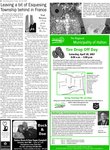Leaving a bit of Esquesing Township behind in France
- Publication
- Independent & Free Press (Georgetown, ON), 20 Apr 2007, p. 10
- Full Text
After leaving the quaint medieval order of Ypres (Ieper) Belgium, we've had a three-day stay in Bayeux, Normandy, France. The coast of Normandy is the centre of the Second World War arena, with D-Day, June 6, 1944, the most significant historical event to occur in this region of Europe. I've seen the beaches of Normandy before, walked on Juno Beach, seen the famous Queen's Own Rifles' house located there, and visited Pegasus' Bridge, where the 6th British Airborne landed three huge gliders in a space less than 50 yards long, to take the bridge intact, that very early morning in June of 1944. And I've visited the Canadian War Cemetery at Beny-sur-mer, which is located less than two miles from Juno Beach. It's a beautiful cemetery, perfectly manicured, with all the grave stones standing so straight and proud. Knowing I would be visiting this cemetery again, I contacted a friend of mine. Rob Burnett and I have been friends for years. His daughter Anna, and my daughter Jenn, have been good friends since Kindergarten, and still get together when they happen to be home from university. Rob and I also share another common interest-- we both live in our original family homesteads. His house is quite similar to mine, in both age and design. During my last visit to the Beny-surmer Cemetery in 2005, I read the honour roll for local troops buried there. I realized that Rob's uncle, Lieutenant John Edward Bowman, was one of the thousands buried there. He died June 22, 1944, 16 days after the first troops landed on the beaches of Normandy. At that time, I made sure I photographed the grounds of the cemetery, the grave stone and as much of the area, so I could present Rob with a memory of where his uncle's final resting place is. When I learned this year's Keeping the Memory Alive Tour itinerary would be once again stopping at Benysur-mer, I knew I had to give Rob a chance to take advantage of my visit. I left a message with his wife Sandy, suggesting I would place something on the grave if he wanted me to. Rob called me back the night before I flew out. "I'd like to come over for a bit Ted," said Rob, "I have something to place on Uncle John's grave." True to form, Rob landed in with two beers in hand, and a little Zip-loc bag. "It's some stones from the creek bed at home," explained Rob, "When I visited my mom today, we talked about what to place on the grave. We agreed that stones from the creek would be appropriate, since she said Uncle John loved to play in that creek as a boy. "We figured, that way, Uncle John has a little bit of old Esquesing Township over in France with him, and it will stay there forever." I was quite moved by their choice, and gladly accepted the task to bring a little home back to one of our war dead of so many years ago. As I made my way to the grave, I looked at the tiny stones, all washed and clean from a steady flow of water over them for hundreds of years. I kneeled down, and took the 15 small stones, and arranged them in a tiny cross, in the earth of the flowerbed around the stone marker. It was a nice feeling, as I read the name-- "Lt. John Edward Bowman, of the Royal Canadian Infantry Corps, attached to 6th Battalion, Royal Scots Fusiliers." I wondered if he was looking down on me, smiling at the tiny bit of Esquesing Township I had presented to him. I know the next time the groundskeepers weed the gardens and loosen the earth around the grave stone, those pebbles will be worked into the soil. But I also know that they will be timeless, and it doesn't really matter if they remain in the shape of a cross or not, they will be with John forever-- as will the thoughts of those who knew him, when he was cut down during the fighting following D-Day. Naturally, I never met John Bowman-- he was killed before I was even born. But after today, I feel like I'm a friend of his. A friend who is most indebted to him for his sacrifice.
Independent & Free Press reporter/photographer Ted Brown helped a friend bring a bit of Esquesing Township to France and at the same time pay tribute to his uncle killed in the Second World War. Brown placed rocks, gathered from a local creek, on the soldier's grave at the Canadian War Cemetery in Beny-sur
- Featured Link
- Creator
- Brown, Ted
- Media Type
- Newspaper
- Item Types
- Articles
- Clippings
- Photographs
- Date of Publication
- 20 Apr 2007
- Subject(s)
- Personal Name(s)
- Borwn, Ted ; Brunett, Rob ; Brunett, Sandy
- Local identifier
- Halton.News.222025
- Language of Item
- English
- Copyright Statement
- Copyright status unknown. Responsibility for determining the copyright status and any use rests exclusively with the user.
- Contact



